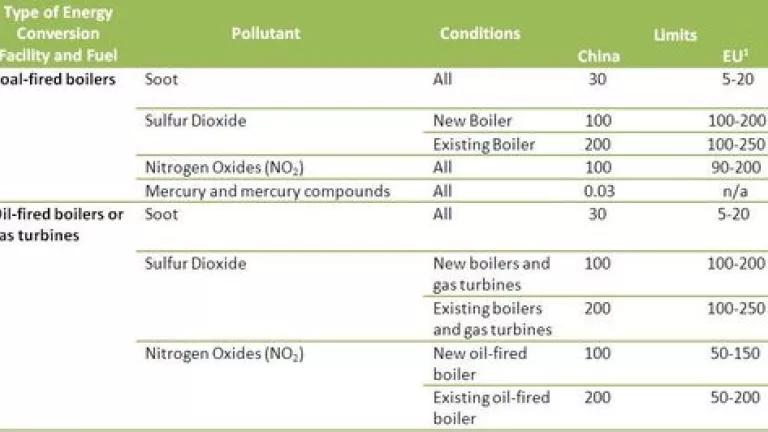Blue Skies for 2012: Cutting Air Pollution and Strengthening Information Transparency in China

Power plant emissions and air quality standards targeting some of the most harmful impacts of coal are coming under greater scrutiny starting this year in China. As of January 1, new thermal power plants have tougher restrictions on soot, sulfur dioxide and nitrogen dioxides (92% of the current fleet is coal-fired). Mercury will be controlled starting in 2015. Small particulate matter and ozone standards will take effect nationwide in 2016; Beijing announced just last week that it would publicly release small particulate matter (PM 2.5) data before February of this year. Followed closely by the U.S. unveiling new toxics controls on power plants last month, both countries are in a “race to the top” for greater health and environmental protections for its citizens. This is a race we must all win.
On September 21, China’s Ministry of Environmental Protection (MEP) released new thermal power plant emission standards that will tighten controls on soot, sulfur dioxide (SO2) and nitrogen dioxide (NO2). Newly constructed power plants are obligated to follow the standards which began on January 1, 2012. For existing power plants, the new standards will take effect starting July 1, 2014. Read NRDC’s unofficial English summary (regulations in Chinese). A side-by-side comparison with the European Union is below[1].
Air Pollutant Emission Standards Comparison Table -- China and the European Union (EU) Units: mg/m3
The new standards also set strong limits on the emission of mercury and its compounds. The coal industry is the single largest source of mercury emissions in the world and China leads the pack consuming 47% of the world’s coal. All power plants (new and existing) will be regulated starting in 2015. Studies have shown that high levels of mercury in our fish can be damaging to the nervous system and impair a child’s ability to think and learn.
By setting mercury emission standards, China is not only dealing with pollution’s domestic costs, it is making a global statement. The U.S. just recently inaugurated national limits on mercury or other toxic pollutants released from power plant smokestacks, reaching full compliance by 2016. This is one of President Obama’s “biggest environmental accomplishments” to date. By contrast, the European Union’s Heavy Metal Protocol does not give a specific emission limit value on mercury (pdf).
Some ambiguities in the regulations do require further clarification. Enforcement and participatory supervision of these types of standards have proved difficult in the past, which we are working to strengthen. In addition, key regions with “concentrated development and low environmental capacity” will face even tougher standards (see table 2 in the regulations). However, the geographic scope and timeline are undefined, subject to further regulation by the MEP.
Major energy companies are already complaining that these new standards will be too costly. We’ve heard the same reprieve in the U.S. about mercury and toxics, but the facts are more compelling: health benefits to Americans will be up to nine times greater than the costs of compliance to power plants. The wide losses of Chinese energy giants this year due to the increasing costs of coal are a compelling case for effective pricing reform, not sacrificing public welfare. Market mechanisms – such as the Jiangxi provincial pilot raising electricity prices for a batch of energy-intensive factories through the end of 2011 – will be crucial if China is to achieve its 12th Five-Year Plan goals.
Shortly after publishing power plant emission standards, in November 2011, MEP opened public feedback on revised environmental air quality standards (Chinese) that will include for the first time PM 2.5 (fine particles smaller than 2.5 microns in diameter) and ozone levels. Just last week, Beijing’s Municipal Environmental Protection Bureau announced that it will begin releasing PM 2.5 data to the public before the Chinese New Year on January 23. Currently, China lacks air quality standards for monitoring PM 2.5, which causes aggravated risks for lung and heart disease. MEP says a new air quality index standard, including PM 2.5 and ozone measurements, will be implemented nationwide in 2016.
Though these standards must be tightly controlled and effectively monitored, it is encouraging to see that Beijing is responding to the costs of air pollution and unregulated coal development. With these new emission and air quality standards, China may benefit from fresher air, cleaner water and healthier citizens in 2012 and beyond.
This post was co-authored with NRDC’s Craig Spencer and Michael Davidson.
Summary of the Air Emission Standards on Thermal Power Plants (NRDC, 2012)
[1] “Integrated Pollution Prevention and Control (IPPC), Executive Summary, Reference Document on Best Available Techniques for Large Combustion Plants,” May 2005. Units are in mg/m3. Standards come from plants with a capacity of 100-300 MWth.
